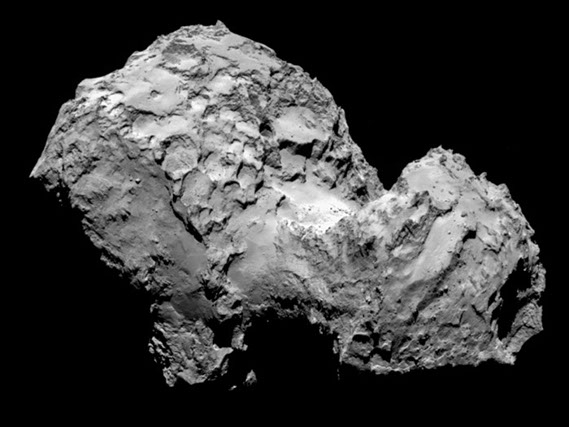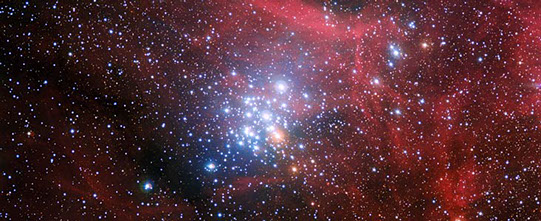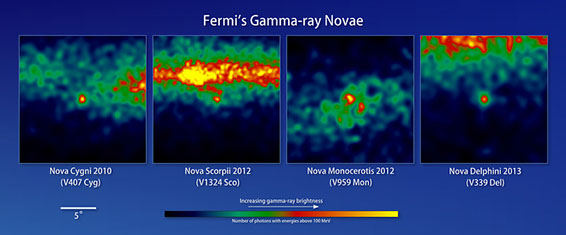



August 2014
Rosetta
Rosetta has arrived at comet 67P/Churyumov-Gerasimenko. Rosetta, operated by the European Space Agency (ESA), is the first spacecraft to rendezvous with a comet.
The comet is 405 million kilometers from Earth, about half way between the orbits of Jupiter and Mars. The comet is traveling at a speed of 55,000 kilometers per hour and headed towards the inner solar system. Over the next 15 months, Rosetta will follow the comet as it swings around the sun and heads back out toward Jupiter. The comet's orbit runs elliptically from beyond Jupiter to a point between Earth and Mars, taking about 6.5 years to complete one orbit.
As Rosetta approached the comet, the science began. The first photos from the OSIRIS camera showed the comet's coma (the tail of gas and dust) had a variable brightness, getting brighter and then dimmer over a 6 week period. The first measurements from MIRO (Microwave Instrument for the Rosetta Orbiter) showed the comet was emitting water vapor into space at about 300 milliliters per second. VIRTIS (Visible and Infrared Thermal Imaging Spectrometer), measured the average temperature of the comet to be about -70 degrees C. (-94 F). Rosetta has 11 different science instruments on board.
Initially Rosetta parked itself 100 km from the comet surface. Over the next 6 weeks, the spacecraft will move closer to about 50 km away. Depending on conditions, Rosetta may eventually move even closer to 30 km or less.
The next order of business for Rosetta is to locate a landing site for the Philae lander. Philae is currently scheduled to land on the comet on 11 November, but a final date will not be decided upon until the middle of October. The gravity on the comet is several hundred thousand times less than that on Earth, so the lander has two harpoons that will hold it onto the comet in addition to each foot having a ice screw capable of anchoring the lander on a slope of up to 30 degrees.
The lander Philae has 10 instruments on board including a drill that will be able to sample the comet at a depth of 23 cm.
Comets are among the oldest objects in the solar system. After the sun was born about 5 billion years ago, the dust and rocks and gases present in the cloud surrounding the sun came together and formed the planets. But many chunks did not combine or fuse with others and these are the comets we see today, roaming the solar system virtually unchanged over the past 5 billion years. So by studying comets we are able to study what was present and the original composition of the cloud of dust and gas that became our solar system.
Previous studies have shown that comets contain complex organic molecules and there are theories that propose comets originally seeded the Earth with the amino acids essential to create life. Although Rosetta will not be able to prove this theory, it will be able to directly measure the amount of compounds of carbon, oxygen, hydrogen and nitrogen in the comet and detect a variety of amino acids.
Rosetta has been on quite a journey to get to the comet. It was launched in 2004 aboard an Ariane 5 rocket and has made three gravity assist flybys of Earth and one of Mars. It has looped around the sun five times and has traveled 6.4 billion kilometers. And now, as ESA Director General Jean-Jacques Dordain put it, the "Discoveries can start".

Comet 67P/Churyumov-Gerasimenko by Rosetta’s OSIRIS narrow-angle camera on 3 August from a distance of 285 km.
Credit:ESA/Rosetta/MPS for OSIRIS Team MPS/UPD/LAM/IAA/SSO/INTA/UPM/DASP/IDA
Visit our sponsors.
For advertising opportunities on this page and our videos, contact
Upcoming Launches
NO LAUNCHES SCHEDULED FOR AUGUST
Date: September
Launch Vehicle: Space-X
Launch Site: Cape Canaveral AFS, Florida
Description: Deliver cargo and crew supplies to the ISS.
Stardust
Cosmic dust. It is found throughout the Universe. But little is known of its origins or how it grows. But now a team of scientists using ESO's Very Large Telescope in Chile has studied a supernova over the course of several years and has learned much about the dust formed in the explosion.
They found that dust formation begins soon after the explosion and continues for a long period of time. But the astronomers think the dust formed in the material the star shed out into space BEFORE it exploded. A cool dense shell of gas is formed as the supernova's shockwave expands. These are the ideal conditions for the dust grains to seed and grow. But this is only the first stage.
The second stage begins several hundred days after the explosion. This is an accelerated dust formation process in the ejected material from the supernova.
The team was also able to answer the question of how the dust can survive the massive explosion. They observed the dust grains are larger than one thousandth of a millimeter and form rapidly in the dense material surrounding the star. The size of the grains is larger than expected and explains how they survive the explosion.
Misaligned Planet Orbits
It has been found that many exoplanets have strange inclined orbits around their sun, unlike our solar system where the planets orbit in the same plane. Observing planets being formed in the HK Tauri binary system, we see this phenomena taking place. Using the Atacama Large Millimeter/submillimeter Array (ALMA) in Chile, astronomers have gotten the first closeup views and the sharpest photos ever of planet formation in a double star system.
The HK Tauri system is found in the constellation Taurus. The stars are less than five million years old and orbit each other at a distance of 58 billion kilometers. HK Tauri B is the fainter of the two stars and we view the planet forming disk edge-on. HK Tauri A is the brighter star and we view it straight-on.
The disk of HK Tauri A is so bright we cannot view it optically, but using the millimeter wavelengths which ALMA sees, the planet disks come into view. One of the disks is tilted over 60 from the plane of the other and is not in the plane of orbit of the two stars.
One theory of why this occurs is the gravitational forces of the two stars impacting the disks of gas and dust as they begin to rotate around their respective star. Scientists now need to study other planet forming stars to see if this is common in the Milky Way or not.

Artist Concept.
Credit: R. Hurt (NASA/JPL-Caltech/IPAC)
Open Clusters
An open cluster is a group of stars formed at the same time out of the same cloud of dust and gas. As a result, all the stars contain the same chemical makeup. But the stars in a cluster are not always alike in size.

This photo is of the open cluster NGC 3293, found in the constellation Carina. It was taken with ESO's La Silla Observatory in Chile. The stars are all less than 10 million years old, making them young stars. But notice that there is a red giant in the litter. A red giant is a star nearing the end of its life, expanding and cooling down. But this red giant is the same age as the other bluish stars you see.
The red giant was born as a large star compared to its sibling stars. Since it was so big, it burned its fuel at a faster speed than the other stars. In essence, it aged faster and burnt out faster than the others. These stars are only 10 million years old, compared to our sun that is 4.6 BILLION years old. Yet this young star, being born so large, has reached old age very quickly.
By studying star clusters, astronomers can compare stars formed at the same time out of the same cloud of gas. Looking at the differences amongst these stars, they gain valuable knowledge in the life and behavior of stars.
There are two types of star clusters. Open clusters, as this cluster is, and Globular clusters. Open clusters have less stars in them and are much younger than stars found in a Globular cluster. Because there are less stars in an Open cluster, over time the cluster's gas and dust dissipates and the gravitation no longer holds the stars near each other. The large density of stars in a Globular cluster on the other hand, create enough gravity that the cluster stays together for billions of years. So you typically find very old stars in a Globular cluster but only young stars in an Open cluster.
Gamma-Rays in Novae
Gamma-rays are the most energetic forms of light we know of in the Universe. They are formed in powerful cosmic blasts like supernovae. But, until now, no one thought they could be formed in smaller Nova explosions.
A nova occurs when a thermonuclear explosion takes place on the surface of a white dwarf star. Each nova releases 100,000 times the annual energy of our sun. Now NASA's Fermi Gamma-Ray space telescope has detected gamma-ray busts in not one, but four nova explosions.
What drives this is unknown. Where could so much energy come from? One theory is that a nova will create multiple shock waves expanding at different speeds. When the faster waves overtake the slower waves, the particles in them accelerate to near light speed. These particles then produce the gamma-rays.

Credit: NASA/DOE/Fermi LAT collaboration
Distant Lens Galaxy Found
The Hubble space telescope has found a distant "lensing' galaxy. Located 9.6 billion light years away, it is 200 million light years farther than any other lensing galaxy detected.
A "lensing" galaxy is so massive that it's gravity bends magnifies and distorts light from objects behind it. In this case, there is a spiral galaxy behind this "cosmic lens". The spiral galaxy is 10.7 billion light years away, so we see it as it appeared 10.7 billion years ago. The tiny spiral galaxy is undergoing a rapid burst of star formation.
Locating a 'lensing' galaxy this far away is a rare find. The giant galaxy is very massive for its time. By comparing this galaxy to the hundreds of nearby lens galaxies, astronomers hope to gain insight on dark matter and how it evolves over time. Astronomers thought that dark matter built up equally with normal matter in a galaxy over time, but now know the ratio of dark matter to normal matter has changed over time.

Credit: ESO/G. Beccari
© 2014-2016 Ted Cook Productions LLC. - All Rights Reserved